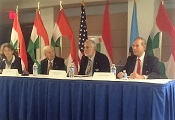 10/13/2016 - AHF Chairman addresses National Defense University on the 60th anniversary of the 1956 Hungarian Revolution. "I remember that as I matured, the often articulated view that 'well, we couldn’t go to war over Hungary' somehow didn’t quite sound right to me." The presentation appears in full below. 10/13/2016 - AHF Chairman addresses National Defense University on the 60th anniversary of the 1956 Hungarian Revolution. "I remember that as I matured, the often articulated view that 'well, we couldn’t go to war over Hungary' somehow didn’t quite sound right to me." The presentation appears in full below.
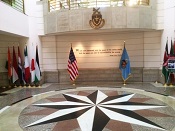 On October 12, National Defense University hosted a conference titled "1956: The Freedom Fight that Changed the Cold War: Geopolitics and Defense Policy." Hungarian Ambassador Dr. Reka Szemerkenyi and Senior Vice President of the NDU Ambassador Donald Yamamota opened the seminar. The keynote speaker was Hungary's Defense Minister Dr. Istvan Simicsko. A number of scholars, authors and government officials served on the various panels, including James J. Townsend, Deputy Assistant Secretary of Defense for European and NATO Policy, Imre Toth, member of the Revolutionary Government of Hungary in 1956, Dr. Tamas Magyarics from the Minister of Foreign Affairs and Trade and General Peter B. Zwack from the NDU. On October 12, National Defense University hosted a conference titled "1956: The Freedom Fight that Changed the Cold War: Geopolitics and Defense Policy." Hungarian Ambassador Dr. Reka Szemerkenyi and Senior Vice President of the NDU Ambassador Donald Yamamota opened the seminar. The keynote speaker was Hungary's Defense Minister Dr. Istvan Simicsko. A number of scholars, authors and government officials served on the various panels, including James J. Townsend, Deputy Assistant Secretary of Defense for European and NATO Policy, Imre Toth, member of the Revolutionary Government of Hungary in 1956, Dr. Tamas Magyarics from the Minister of Foreign Affairs and Trade and General Peter B. Zwack from the NDU.
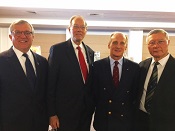 Frank Koszorus, Jr., Chairman of the American Hungarian Federation’s Board of Directors, spoke on a panel titled “The Memory of 1956 Revolution and Freedom Fight." He focused on the Eisenhower administration's “hands off policy” and how vigorous and imaginative diplomatic initiatives would have been far short of “starting World War III” yet would have gone beyond giving the appearance of acquiescence and possibly could have changed the course of the Cold War. Koszorus also touched upon an often forgotten consequence of the Soviet invasion of Hungary in 1956 – a more aggressive anti-Hungarian minority policy in Romania. Frank Koszorus, Jr., Chairman of the American Hungarian Federation’s Board of Directors, spoke on a panel titled “The Memory of 1956 Revolution and Freedom Fight." He focused on the Eisenhower administration's “hands off policy” and how vigorous and imaginative diplomatic initiatives would have been far short of “starting World War III” yet would have gone beyond giving the appearance of acquiescence and possibly could have changed the course of the Cold War. Koszorus also touched upon an often forgotten consequence of the Soviet invasion of Hungary in 1956 – a more aggressive anti-Hungarian minority policy in Romania.
LOOKING BACK AT THE HUNGARIAN REVOLUTION OF 1956: PERCEPTIONS, IMPRESSIONS AND REALITY
Frank Koszorus, Jr.
"1956: The Freedom Fight that Changed the Cold War – Geopolitics and Defense Policy" -
The Memory of the 1956 Revolution and Freedom Fight
October 12, 2016
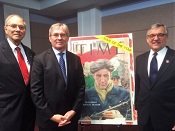 Memories of a Young Boy. Memories of a Young Boy.
As a 9 year old during the Hungarian Revolution of 1956, I vividly remember being glued to the television set with my parents, mesmerized by the frightening images unfolding of freedom fighters battling Soviet tanks with only small arms and Molotov cocktails.
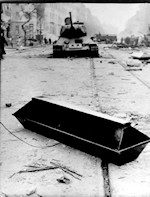 I remember the anguish of my parents as Soviet troops systematically and brutally crushed a small nation which dared to take up arms to realize its desperate but unequivocal and unquenchable desire to be free and independent. I remember the anguish of my parents as Soviet troops systematically and brutally crushed a small nation which dared to take up arms to realize its desperate but unequivocal and unquenchable desire to be free and independent.
I remember my father’s utter frustration with President Eisenhower’s reluctance to fully address this crisis, not knowing at the time that in the early 1950’s my father had been entrusted to establish an organization to conduct paramilitary activities favoring freedom within Hungary, an initiative that ended before 1956 and presaged the demise of “rollback” which, as it turned out, was more rhetoric than operational policy.
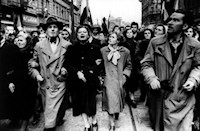 I remember the rallies, one in particular where movie star Ilona Massey addressed the gathering wearing a bright, shining blue dress with her blonde hair flowing in the wind and tears unstoppably streaking down her cheeks, as she pleaded that something, anything, must be done to stop the carnage. I remember the rallies, one in particular where movie star Ilona Massey addressed the gathering wearing a bright, shining blue dress with her blonde hair flowing in the wind and tears unstoppably streaking down her cheeks, as she pleaded that something, anything, must be done to stop the carnage.
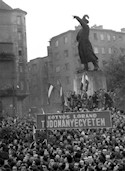 I remember how with childish naivete my playmates and I developed future plans to parachute into Hungary to help ward off the enemy. Finally, I remember that as I matured, the often articulated view that “well, we couldn’t go to war over Hungary” somehow didn’t quite sound right to me. I remember how with childish naivete my playmates and I developed future plans to parachute into Hungary to help ward off the enemy. Finally, I remember that as I matured, the often articulated view that “well, we couldn’t go to war over Hungary” somehow didn’t quite sound right to me.
Maturing and Learning.
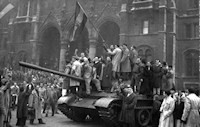 It was only later when I majored in history and international relations in college that I started delving into the history of the Revolution and discovered that perhaps there could have been another outcome to the tragedy of 1956. It was only later when I majored in history and international relations in college that I started delving into the history of the Revolution and discovered that perhaps there could have been another outcome to the tragedy of 1956.
I discovered that Moscow was divided as to how to react to the Hungarian events and that only after it was obvious that the West, including the United States, would do nothing to help the Hungarians that Khrushchev decided to intervene militarily.
As noted by Martin Ben Swartz, “[f]rom the start. . .the [Eisenhower] Administration took a defensive and defeatist attitude toward the Hungarian Revolution.” A few examples supporting this conclusion include the following:
On October 25, Secretary of State John Foster Dulles suggested that the United States attempt to place the Hungarian crisis on the Security Council’s agenda. President Eisenhower overruled him.
Instead, President Eisenhower embarked on a policy of reassuring Moscow of American non-involvement in Eastern Europe. Thus on October 27 Secretary Dulles stated that the United States does not look “upon these [satellite] nations as potential military allies.”
On October 28 Henry Cabot Lodge, U.S. Ambassador to the U.N., was ordered to bring Secretary Dulles’ speech up at the Security Council and to be sure to quote that clause -- “We do not look upon these nations as potential military allies.”
And to drive the “hands-off” policy home to the Soviet leadership, U.S. Ambassador to Moscow Charles “Chip” Bohlen was directed to bring the key points of Dulles’ speech to the attention of Khrushchev and Marshal Zhukov, which he did. Equally surprising and inexplicable was President Eisenhower’s speech on October 31, only one week after the Revolution had begun, which, as Henry Kissinger noted, “ was particularly notable for its omission of so much as a hint that the Soviet Union would incur penalties if it resorted to repression.”
The absence of public and private efforts to pressure the Soviets to remove their forces from Hungary was equaled by the Eisenhower Administration’s refusal to diplomatically interact with Imre Nagy, prime minister of Hungary, or to vigorously support diplomatically Hungary's declared neutrality.
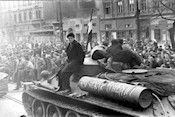 As argued by Martin Ben Swartz, “[t]he [American] Legation in Budapest had already put its finger on the crux of the problem with the Administration’s policy toward Hungary. Why was the United States not making it known that the Warsaw Treaty was a sham, that the Soviet Union had no basis for keeping its troops in Hungary? [It was a sham because of the coercive nature of the military arrangement imposed by the Soviet Union.] Why was Eisenhower not insisting that those forces be withdrawn? The Legation saw little risk to the US in calling upon Khrushchev to withdraw from Hungary.” As argued by Martin Ben Swartz, “[t]he [American] Legation in Budapest had already put its finger on the crux of the problem with the Administration’s policy toward Hungary. Why was the United States not making it known that the Warsaw Treaty was a sham, that the Soviet Union had no basis for keeping its troops in Hungary? [It was a sham because of the coercive nature of the military arrangement imposed by the Soviet Union.] Why was Eisenhower not insisting that those forces be withdrawn? The Legation saw little risk to the US in calling upon Khrushchev to withdraw from Hungary.”
Endre Marton who had ties to Imre Nagy stressed that “what disappointed us most about the United States response was not that there were no efforts to assist us militarily, but that there was no American diplomatic pressure against Moscow.”
Consequences. Vigorous and imaginative diplomatic initiatives instead of feckless policies would have been far short of "starting World War III." But they would have gone beyond giving the appearance of acquiescence and possibly could have changed the course of the Cold War.
The latter was attested to by Oleg Penkovskiy, a colonel with Soviet intelligence, when he later wrote the following in connection with the Hungarian events: “We in Moscow felt as if we were sitting on a powder keg. Everyone in the General Staff was against the ‘Khrushchev adventure.’ It was better to lose Hungary, as they said, than to lose everything. But what did the West do? Nothing. It was asleep.
This gave Khrushchev confidence, and after Hungary he began to scream: 'I was right!' After the Hungarian incident he dismissed many generals who had spoken out against him. If the West had slapped Khrushchev down hard then, he would not be in power today and all of Eastern Europe would be free.” Henry Kissinger succinctly concluded, the “Eisenhower Administration made no effort to raise the cost of Soviet intervention.”
Consequences?
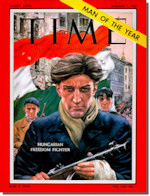 According to Kissinger, the “juxtaposition of Hungary and Suez established the coordinates of the next phase of the Cold War. . .The United States had left Hungary adrift in the sea of historical evolution, and American allies with a sense of their impotence.” According to Kissinger, the “juxtaposition of Hungary and Suez established the coordinates of the next phase of the Cold War. . .The United States had left Hungary adrift in the sea of historical evolution, and American allies with a sense of their impotence.”
And today? Quoting a Hungarian novelist,“the West deserted us once; will it welcome us now?’ as Hungary finally prepared to join NATO, Georgetown University Professor Derek Leebaert observes that “such memories would help shape the twenty-first century landscape.”
In addition to the suffering and oppression of Hungarians in Hungary proper in 1956 and the memory of that suffering noted above, the massive Soviet invasion and the brutal crushing of the unequivocal expression of Hungarians to be free also impacted the Hungarian communities in states neighboring Hungary – a development that is virtually forgotten today.
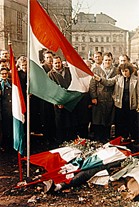 For instance, one consequence was the solidly Stalinist Romanian government's virtual liquidation of the Hungarian-language Bolyai University in Romania, which was implemented by the secretary of the Central Committee, Nicolae Ceausescu along with other anti-minority policies. Communal properties confiscated by the previous regime have yet to be fully restored to the Hungarian minority. For instance, one consequence was the solidly Stalinist Romanian government's virtual liquidation of the Hungarian-language Bolyai University in Romania, which was implemented by the secretary of the Central Committee, Nicolae Ceausescu along with other anti-minority policies. Communal properties confiscated by the previous regime have yet to be fully restored to the Hungarian minority.
Remedies.
Righting wrongs against Hungarian minorities that extend back to the Cold War period and respecting the rights of such minorities would be a fitting commemoration of 1956 and a tribute to the memory of thousands of unsung heroes who did not compromise but sacrificed their lives for the cause of liberty sixty years ago.
Today, Hungary is a committed NATO and strong U.S. ally and a multi-party democracy, albeit an imperfect and evolving one, as even mature democracies evolve. Having regained its freedom from Soviet domination a mere twenty-six years ago, the moral, spiritual and material damage caused by close to fifty years of Soviet imposed communism is still visible.
Nevertheless, Hungary’s support for United States foreign policy goals stands in marked contrast to West European ambivalence about U.S. global leadership after the end of the Cold War. Hungarian identification with the U.S. extended beyond elite opinion and was rooted strongly in the popular imagination.
This reservoir of popular support was a precious commodity that gave U.S. foreign policy a competitive advantage in the region during the Cold War and the years that have followed. It is a commodity we need to nurture today in order for us to be able to effectively stand up against growing Russian aggression and to combat terrorism.
This instinctive popular support, however, has been at risk in Hungary in recent years, mainly due to the perception of a lack of evenhandedness in addressing the political landscape there. It is also due to a constant barrage of public, humiliating and patronizing criticism questioning Hungarians’ commitment to freedom and liberty.
1956 starkly refutes this misleading and skewed picture of Hungarians and amply justifies the restoration of good bi-lateral relations. Let’s not misjudge what is occurring on the ground as we misjudged the events in 1956 and paid a high price. We should remain constructively engaged in Hungary.
Finally, in order to strengthen and safeguard liberty throughout the region, today's generation -- the beneficiary of the restored freedoms following the demise of communism -- must be vigilant and guard against any curtailment of democracy and infringement of fundamental human rights and Western standards relating to minority rights. A free, independent, democratic and pro-Western society is the legacy of 1956 that should not be permitted to fade.
References
- Peter Grose, Operation Rollback: America’s Secret War Behind the Iron Curtain (Boston: Houghton Mifflin Company, 2000)
- Henry Kissinger, Diplomacy (New York: Simon & Schuster, 1994), pp. 563, 566 and 558.
- Derek Leebaert, The Fifty-Year Wound: The True Price of America’s Cold War Victory (Boston: Little, Brown and Company, 2002), p. 201.
- Oleg Penkovskiy, The Penkovskiy Papers, trans. Peter Deriabin (New York: Doubleday & Company, Inc., 1965), pp. 212 and 213.
- Martin Ben Swartz, A New Look at the 1956 Hungarian Revolution: Soviet Opportunism, American Acquiescence (Ann Arbor: U-M-I Dissertation Service, 1989). Pp. 207, 304, 305, 307, 308 and 313
[<< Back to 1956 News]
[<< Back to All AHF News]
| [<< Back to 1956 News]
The 1956 Hungarian Revolution was the first tear in
the Iron Curtain. Hungarians from all walks of life rose up against insurmountable
odds to fight the brutal Soviet installed Hungarian communist government.
Thousands died fighting, others tortured and executed, while 200,000 were
forced to flee. 2006 marked the 50th Anniversary of the Hungarian Revolution.
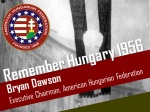 10/24/2013 - AHF Executive Chairman delivers multimedia presentation entitled "Reflections on the 1956 Hungarian Revolution" for the Shepherd Center World Affairs Series coordinated by A. Ross Johnson, Wilson Center Senior Scholar, Hoover Institution Research Fellow, and former Director of Radio Free Europe. Bryan Dawson, whose mother was wounded in the Freedom Fight, discussed the roots of the conflict and Polish-Hungarian sympathies, Hungary's history and national character that contributed to the uprising, and the Revolution's impacts internationally. [read more] 10/24/2013 - AHF Executive Chairman delivers multimedia presentation entitled "Reflections on the 1956 Hungarian Revolution" for the Shepherd Center World Affairs Series coordinated by A. Ross Johnson, Wilson Center Senior Scholar, Hoover Institution Research Fellow, and former Director of Radio Free Europe. Bryan Dawson, whose mother was wounded in the Freedom Fight, discussed the roots of the conflict and Polish-Hungarian sympathies, Hungary's history and national character that contributed to the uprising, and the Revolution's impacts internationally. [read more]
  New
Video posted to the AHF 1956 Portal! "News Magazine of the Screen"
presented "Flight from Hungary" in early 1957 featuring video
taken after the brutal oviet re-occupation. "This is battered Budapest
under the brutal Russian boot, Soviet tanks roam the streets under the
ruins they laid as communist secret police hunt down heroic Freedom Fighters.
25,000 Hungarians are dead." A fascinating video, it also includes
news about the Suez Crisis and more glimpes into life during this time.
[See all Photos and Videos] New
Video posted to the AHF 1956 Portal! "News Magazine of the Screen"
presented "Flight from Hungary" in early 1957 featuring video
taken after the brutal oviet re-occupation. "This is battered Budapest
under the brutal Russian boot, Soviet tanks roam the streets under the
ruins they laid as communist secret police hunt down heroic Freedom Fighters.
25,000 Hungarians are dead." A fascinating video, it also includes
news about the Suez Crisis and more glimpes into life during this time.
[See all Photos and Videos]
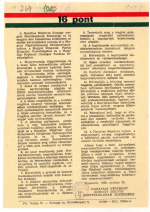 On October 22, 1956, a group of Hungarian students compiled a list of sixteen points containing key national policy demands. They were read at the foot of the General Bem statue, a Polish hero of the 1848 War of Liberation, in solidarity with the anti-communist demonstrations in Poznan, Poland. Following an anti-Soviet protest march through the Hungarian capital of Budapest, the students attempted to enter the city's main broadcasting station to read their demands on the air. The students were detained, and when people gathered outside the broadcasting station to call for their release, the state security police fired on the unarmed crowd, setting off the 1956 Hungarian Revolution. Click the picture to read the 16 points! On October 22, 1956, a group of Hungarian students compiled a list of sixteen points containing key national policy demands. They were read at the foot of the General Bem statue, a Polish hero of the 1848 War of Liberation, in solidarity with the anti-communist demonstrations in Poznan, Poland. Following an anti-Soviet protest march through the Hungarian capital of Budapest, the students attempted to enter the city's main broadcasting station to read their demands on the air. The students were detained, and when people gathered outside the broadcasting station to call for their release, the state security police fired on the unarmed crowd, setting off the 1956 Hungarian Revolution. Click the picture to read the 16 points!
Read more / Tovább:
[ angolul angolul  magyarul] magyarul]
 AHF's work regarding the tragic events nearly 50 years ago, dates
back to the early days of the revolution and thereafter assisting
tens of thousands of refugees. In 1956 the American Hungarian Federation
activated the second Hungarian Relief program for the refugees of the
1956 Hungarian Revolution, providing $512,560.00. With the support of
the American Hungarian Federation, over 65,000 refugees arrived in the
USA. Get involved and help us continue our tradition of helping our community! Join Us! AHF's work regarding the tragic events nearly 50 years ago, dates
back to the early days of the revolution and thereafter assisting
tens of thousands of refugees. In 1956 the American Hungarian Federation
activated the second Hungarian Relief program for the refugees of the
1956 Hungarian Revolution, providing $512,560.00. With the support of
the American Hungarian Federation, over 65,000 refugees arrived in the
USA. Get involved and help us continue our tradition of helping our community! Join Us!
Downloads:
- The Hungarian Revolution - Uprising, Budapest 1956:
A synoptic treatise of a major political event of the 20th Century,
a historically tragic period in the life of a nation commemorating the
50th Anniversary of the Revolution and the fallen brave By: Attila J.
Ürményházi (Hobart, Tasmania) and edited by
Bryan Dawson-Szilágyi [download]
States that
have passed the 1956 Revolution 50th Anniversary Resolution:
| Texas | Ohio | Colorado | Maryland | Virginia |
| Massachusetts | Minnesota | Washington | California | South Dakota |
 4/28/2006
- Texas became the first state to adopt the AHF 1956 resolution
(House Resolution 75). AHF extends sincere thanks to Texas Senator
Janek and Representative Woolley for introducing the measure and to AHF's
Texas Chapter President Chris Cutrone in Austin and Honorary Consul for
Hungary Phillip Aronoff in Houston for their efforts in securing the introuduction
of the resolution. 4/28/2006
- Texas became the first state to adopt the AHF 1956 resolution
(House Resolution 75). AHF extends sincere thanks to Texas Senator
Janek and Representative Woolley for introducing the measure and to AHF's
Texas Chapter President Chris Cutrone in Austin and Honorary Consul for
Hungary Phillip Aronoff in Houston for their efforts in securing the introuduction
of the resolution.
The resolution's title: "Commemorating
the 50th anniversary of the Hungarian Revolution and recognizing the sacrifices
of Hungarian Freedom Fighters, the contributions of Hungarian Americans,
and the friendship between the people and governments of the United States
and Hungary." Full text of the Texas resolution can be found on the Texas
House Website.
The Houston
Chronicle also published an Op-Ed calling attention to the resolution
by Hungarian Honorary Consul Phillip Aronoff in Houston and Bryan Dawson-Szilagyi,
AHF Chairman of the Executive Committee.
 Ohio.
Special thanks to the Hon. Péter Ujvági, Ohio State Representative
(D) who successfully pushed the resolution (#212) through both state houses. [download the resolution] Ohio Governor Taft also issues a proclamation [download] Ohio.
Special thanks to the Hon. Péter Ujvági, Ohio State Representative
(D) who successfully pushed the resolution (#212) through both state houses. [download the resolution] Ohio Governor Taft also issues a proclamation [download]
 Colorado. Colorado.
Special thanks to Jeno Megyessy for introducing a joint resolution that
also makes Octbober 23, 2006 "Hungarian Freedom Fighter's Day"
in Colorado!
[download]
 Maryland. Maryland.
Special thanks to Frank Kapitan for taking the lead in getting the resolution
passed! [download]
 Virginia. Virginia.
Special thanks to Laura Spinner for her leadership in getting Gov. Kaine
to issue this proclamation!
 Massachusetts. Massachusetts.
Special thanks to Hon. Consul of the Republic of Hungary in new England and the Massachusetts Hungarians! [download]
 South Dakota. South Dakota.
State Legislature recognizes the sacrifices of the 1956 Freedom Fighters [download]
 Minnesota. Minnesota.
Congratulations to the Minnesota Hungarians and thanks to the State Legislature for declaring "Hungarian Freedom Day." [download]
In
Memoriam
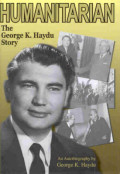 11/15/2005
- AHF President Emeritus, Entrepreneur, Freedom Activist,
and 1959 US "Citizen of the Year," George K. Haydu, passed away
after long illness. The death of this great humanitarian and
leader is a major loss for the Hungarian-American community and to all
his many friends. Despite many death threats and being shot in the leg
during "Loyalty Day" parade in New York City, George was undeterred
in his efforts to bring freedom to Hungary and comfort to refugees. 11/15/2005
- AHF President Emeritus, Entrepreneur, Freedom Activist,
and 1959 US "Citizen of the Year," George K. Haydu, passed away
after long illness. The death of this great humanitarian and
leader is a major loss for the Hungarian-American community and to all
his many friends. Despite many death threats and being shot in the leg
during "Loyalty Day" parade in New York City, George was undeterred
in his efforts to bring freedom to Hungary and comfort to refugees.
[read more about George Haydu]
or see [All Memorials]
--------------
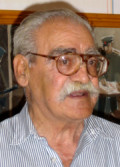 5/19/2005
- Gergely "Bajusz" Pongratz, a leader
and hero of Hungary's anti-communist revolution of 1956, has died at age
73. 5/19/2005
- Gergely "Bajusz" Pongratz, a leader
and hero of Hungary's anti-communist revolution of 1956, has died at age
73.
Pongratz suffered a heart attack on Wednesday in the southern
Hungarian town of Kiskunmajsa where he lived, said Dezso Abraham, secretary
general of the World Council of Hungarian 56ers revolutionary veterans
group. During the revolution, Pongratz was commander of one of the key
resistance groups fighting the Soviet army. [read
more].
--------------
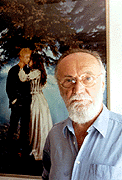 12/10/2004 - JENO SZEREDAS,
90, Hungarian Freedom Fighter Federation Founder, AHF Member, and Noted
Artist Dies... 12/10/2004 - JENO SZEREDAS,
90, Hungarian Freedom Fighter Federation Founder, AHF Member, and Noted
Artist Dies...
Jeno Andras Szeredas, Hungarian political activist and
Senator, 1956 Freedom Fighter, Founder of the Freedom Fighters Federation
in the United States, poet and artist of rare talent died quietly in his
sleep at his daughter's home in Connecticut on November 30. He had just
celebrated his 90th birthday.
Born in Iglo, Hungary (now Slovakia) in 1914, Mr. Szeredas
was both witness to and active participant in the turmoil sweeping over
Europe for the balance of the 20th century. [more]

- 1956 Portal - www.hungary1956.com
- The 1956 Institute,
headed by Dr. Janos Reiner, is a great site devoted to exploring the
1956 Hungarian Revolution in English and Hungarian.
- www.celebratingfreedom1956.org - The Cleveland Hungarian Revolution 50th Anniversary Committee (CHR50)
is organizing a major observance event of this important historical
milestone on October 21st and 22nd, 2006 in Cleveland, Ohio.
- Magyar
Radio Online - includes many audio files and an analysis in Hungarian:
"Ki húzta meg a ravaszt eloször 1956. október
23-án?" "Who was the first to pull the trigger?"
 Time
Magazine gave Hungarian Freedom Fighters the title "Man of
the Year" on July 1, 1957. "The Freedom Fighters filled
the empty bottles with gasoline and corked them with table napkins,
making what they called 'benzine flashes." Time
Magazine gave Hungarian Freedom Fighters the title "Man of
the Year" on July 1, 1957. "The Freedom Fighters filled
the empty bottles with gasoline and corked them with table napkins,
making what they called 'benzine flashes."- www.FamousHungarians.com - offers information on 1956, the 1956 Olympics, the popular
"Nobel Prize Winners and Famous Hungarians," resources on
Trianon, Transylvania, History, Music, and more.
- Wikipedia - the free, online encyclopedia that allows readers to manage its
content!
- The 1956
Institute in Hungary (1956-os Intézet)
- The 1956
Hungarian Revolution Historical Documentation and Research Foundation in Hungary - a source for thousands of photographs from the period
- The National
Security Archive at The George Washington University provides
a wealth of information on the 1956 Revolution available for download
in PDF.
- The
1956 Hungarian Revolution - a short chronology of events with
pictures
- Pal
Maleter on Wikipedia - the military leader of the Hungarian Revolution
- www.sulinet.hu has as site that transcribed many of the various speeches given before,
during, and after the revolution - a fascinating chronology from Nagy
to Mindszenty. (Hungarian)
- Az
1956-os Magyar Forradalom igaz története - in Hungarian.
"What the history books left out." Published by the 1956
World Federation.
- Az
1956-os forradalom története Esztergomban - The Revolution
in Esztergom (in Hungarian)
- Arcok
és sorsok - a great site with photos and biographies of
some 1956 Freedom Fighters
- Nagy
Imre október 23-án: Nagy Imre október 23-án
eleinte hallani sem akart arról, hogy a Parlamentbe menjen
és szóljon a tömeghez. Ám mégis megtette.
Döbbenetet érezhetett, amikor lenézett a Parlament
ablakából, s akkor is, amikor kifütyülték
az „elvtárs” megszólítást.
Beszéde az alant álló ismeretlen erovel szembeni
aggodalmát és szorongását mutatja.
Downloads:
- The Hungarian Revolution - Uprising, Budapest 1956:
A synoptic treatise of a major political event of the 20th Century,
a historically tragic period in the life of a nation commemorating
the 50th Anniversary of the Revolution and the fallen brave By: Attila
J. Ürményházi (Hobart, Tasmania) and edited by
Bryan Dawson-Szilágyi [download]
- US Postal
Service 1956 Petition
Memorials
Dedicated to 1956
"October 23, 1956, is a day that will live forever
in the annals of free men and nations. It was a day of courage, conscience
and triumph. No other day since history began has shown more clearly the
eternal unquenchability of man's desire to be free, whatever the odds
against success, whatever the sacrifice required."-
President John F. Kennedy,
on the first anniversary of the Hungarian Revolution.
- Denver, Colorado - statue and "Hungarian Freedom Park"
- Toronto, Ont - statue and park
- Erie, PA - Memorial and square (Thanks to v. Juhasz Ferenc,
AHF, VP)
- Fairfield, CT - Memorial plaque in Town Hall (2003)
- Berkeley Springs, WV - plaque, cemetery, and church (TX to
Mrs. 'Sally' Gyorik, Ft Vitez Baan OFP)
- Boston, Mass - Liberty Square statue and square by George
Hollosy
- Los Angeles, CA - statue by Arpad Domjan (1966)
(TX to Czene Ferenc and LA Hungarians)
- New York - Plaque at East River/92d Str
- Lorantffy House, Akron, Ohio 1956 - Plaque
- North Olmstead , Ohio - Plaque and cemetery (Thanks to Dobolyi
Arpad & Juhasz Ferenc AHF VP)
- Loraine, Ohio - Statue under construction
- Miami, Fl - First Hungarian Church Stained Glass Windows
- Camp Kilmer - plaque now in New Brunswick, New Jersey
- Cleveland, Ohio - Cardinal Jozsef Mindszenty statue and square
- New Brunswick, NJ - Mindszenty statue and square
- Miami - Mindszenty Str. (27th Str) NW (TX to Tarr Sandor,
Honorary Consul)
- Budapest - statue/plaque at the Chain bridge in Buda by Ocsay
Karoly
- Korvin koz - statue of the young freedom fighter
- Budapest, Prime Minister Imre Nagy Gravsite and Memorial
- Budapest, II kerulet; Manheimer Statue
- Budapest, XIII kerulet: Park of Statues: granite obelisk
- Budapest, XIII kerulet: Park of Statues: Plaque of the martyrs
(2000 Oct. 23)
|
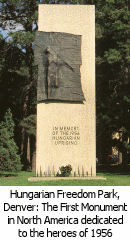
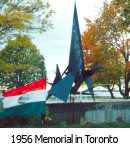
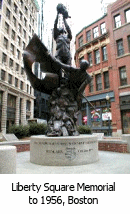
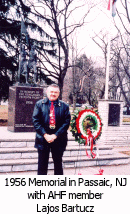
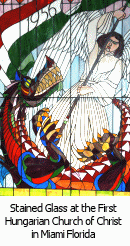
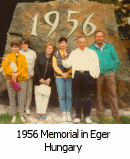
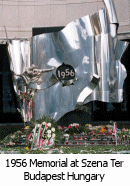
|
 Albert
Camus' Stirring Letter to the World: Albert
Camus' Stirring Letter to the World:
"The Blood of the Hungarians"
I am not one of those who wish to see the people of Hungary
take up arms again in a rising certain to be crushed, under the eyes of
the nations of the world, who would spare them neither applause nor pious
tears, but who would go back at one to their slippers by the fireside
like a football crowd on a Sunday evening after a cup final.
There are already too many dead on the field, and we cannot
be generous with any but our own blood. The blood of Hungary has re-emerged
too precious to Europe and to freedom for us not to be jealous of it to
the last drop.
But I am not one of those who think that there can be a
compromise, even one made with resignation, even provisional, with a regime
of terror which has as much right to call itself socialist as the executioners
of the Inquisition had to call themselves Christians.
And on this anniversary of liberty, I hope with all my
heart that the silent resistance of the people of Hungary will endure,
will grow stronger, and, reinforced by all the voices which we can raise
on their behalf, will induce unanimous international opinion to boycott
their oppressors.
And if world opinion is too feeble or egoistical to do
justice to a martyred people, and if our voices also are too weak, I hope
that Hungary’s resistance will endure until the counter-revolutionary
State collapses everywhere in the East under the weight of its lies and
contradictions.
Hungary conquered and in chains has done more for freedom
and justice than any people for twenty years. But for this lesson to get
through and convince those in the West who shut their eyes and ears, it
was necessary, and it can be no comfort to us, for the people of Hungary
to shed so much blood which is already drying in our memories.
In Europe’s isolation today, we have only one way
of being true to Hungary, and that is never to betray, among ourselves
and everywhere, what the Hungarian heroes died for, never to condone,
among ourselves and everywhere, even indirectly, those who killed them.
It would indeed be difficult for us to be worthy of such
sacrifices. But we can try to be so, in uniting Europe at last, in forgetting
our quarrels, in correcting our own errors, in increasing our creativeness,
and our solidarity. We have faith that there is on the march in the world,
parallel with the forces of oppression and death which are darkening our
history, a force of conviction and life, an immense movement of emancipation
which is culture and which is born of freedom to create and of freedom
to work.
Those Hungarian workers and intellectuals, beside whom
we stand today with such impotent sorrow, understood this and have made
us the better understand it. That is why, if their distress is ours, their
hope is ours also. In spite of their misery, their chains, their exile,
they have left us a glorious heritage which we must deserve: freedom,
which they did not win, but which in one single day they gave back to
us. (October 23, 1957)
AHF dedicates this work
to the memory of all our comrades who passed during those faithful days
of October, 1956.
- Read this in German, Hungarian, French, and Spanish on this AHF member
site, the [American
Hungarian Museum]
Join online!

|




 Frank Koszorus, Jr., Chairman of the American Hungarian Federation’s Board of Directors, spoke on a panel titled “The Memory of 1956 Revolution and Freedom Fight." He focused on the Eisenhower administration's “hands off policy” and how vigorous and imaginative diplomatic initiatives would have been far short of “starting World War III” yet would have gone beyond giving the appearance of acquiescence and possibly could have changed the course of the Cold War. Koszorus also touched upon an often forgotten consequence of the Soviet invasion of Hungary in 1956 – a more aggressive anti-Hungarian minority policy in Romania.
Frank Koszorus, Jr., Chairman of the American Hungarian Federation’s Board of Directors, spoke on a panel titled “The Memory of 1956 Revolution and Freedom Fight." He focused on the Eisenhower administration's “hands off policy” and how vigorous and imaginative diplomatic initiatives would have been far short of “starting World War III” yet would have gone beyond giving the appearance of acquiescence and possibly could have changed the course of the Cold War. Koszorus also touched upon an often forgotten consequence of the Soviet invasion of Hungary in 1956 – a more aggressive anti-Hungarian minority policy in Romania.